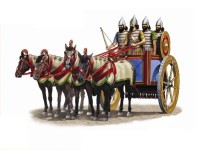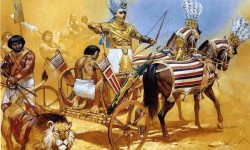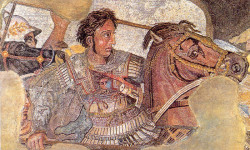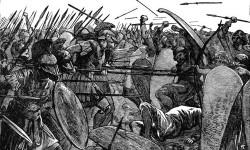With their fearsome and formidable army, the Assyrians had created a tool for their conquest campaigns that had not been there before. In addition, the Assyrians for the first time integrated the systematic exploitation of the defeated to maintain their own armed forces. Rulers like Tiglatpileser III. or Assurbanipal II. were particularly prominent exporters of this new method of warfare.
The rise of Assyria as a great power in the region began in the period around 911 BC, when the rulers Adad-neraris II and a little later Assurnassirpal II were in power. At this time the empire already extended over large parts of Mesopotamia and Lebanon. However, its full size reached the empire only under the ruler Tiglatpileser III. around 745 BC. It was not only the borders to the south and east in the southern Mesopotanien, evacuated to Palestine and eastern Anatolia, the force of Assyria was also first converted into a standing army. Whereupon most of the force consisted of foot soldiers equipped with bows, spears and shields.
The so-called elite of the force formed Assysrische chariot corps and later also cavalry. The Assyrians developed a heavy, four-horse car with 4 man crew, probably consisting of 2 elite fighters and 2 shield carriers who also steered the car. Due to the high number of these chariots a shock effect could be exerted on the opponent in addition to the actual impact force. Despite this effect, the chariot developed later from the Assyrian cavalry, armored and equipped with spears rider which gradually supplanted the heavy chariots from the force.
The military policy of the Assyrian empire was entirely based on the conquests of foreign lands. On the one hand, this could be achieved through sophisticated logistics and, on the other hand, through the fact that the armed forces were supplied by the conquered areas themselves. This was done through resources, food or by soldiers. Maintaining this state was commanded by righteous terror, procrastination and looting sustainability.
The fall of the Assyrian empire was finally initiated by the campaigns of conquest itself. Due to the immense extent far into the south of Egypt neither the borders nor the conquered areas could be protected from enemies and revolts, so that finally 612 BC an amalgamation of the Babylonier, Medern and steppe hordes conquered and plundered the Assyrian capital Ninive. The remnants of the Assyrian army, along with the Egyptians, resisted for some time, but in the devastating defeat against the Chaldean Babylonians at Carchemish in 605 BC, the era of Assyria ended altogether.
You can find the right literature here:
Assyrian History: A Captivating Guide to the Assyrians and Their Powerful Empire in Ancient Mesopotamia

Assyrian History: A Captivating Guide to the Assyrians and Their Powerful Empire in Ancient Mesopotamia Paperback – September 26, 2018
Located in modern-day Iraq, ancient Mesopotamia, the land between the great Tigris and Euphrates rivers, is where it all began. It’s the part of the world where some 6,000 years ago people finally said goodbye to their lives as hunters and gatherers, started farming, and began building civilizations. It’s from these civilizations that we get some of the most famous contributions to world history and culture, from the Epic of Gilgamesh to Hammurabi’s famous code of law, which gave rise to the popular saying “an eye for an eye.”
The story of Mesopotamia is one that is full of constantly changing borders, rising and falling civilizations, and, of course, war and conquest. The world’s first empires would emerge here and spend thousands of years exchanging territories, swapping alliances, and fighting for supremacy. It was a real-life game of Risk being played out by some of the world’s most revered, yet feared, leaders.
But of all the famous civilizations to emerge from Mesopotamia, a list that includes the Akkadians, the Sumerians, and the Babylonians, it’s the Assyrians who deserve the fame and glory. The empire they constructed over the course of some 1,200 years survived constant attacks, a few defeats, and the famed Dark Age known as the Bronze Age collapse to become one of the largest and most expansive empires the world has ever seen.
The Assyrians: The History of the Most Prominent Empire of the Ancient Near East

The Assyrians: The History of the Most Prominent Empire of the Ancient Near East Paperback – September 18, 2014
*Includes pictures
*Discusses Assyrian military tactics, religious practices, and more
*Includes ancient Assyrian accounts documenting their military campaigns and more
*Includes a bibliography for further reading
“I fought daily, without interruption against Taharqa, King of Egypt and Ethiopia, the one accursed by all the great gods. Five times I hit him with the point of my arrows inflicting wounds from which he should not recover, and then I laid siege to Memphis his royal residence, and conquered it in half a day by means of mines, breaches and assault ladders.” - Esarhaddon
“I captured 46 towns...by consolidating ramps to bring up battering rams, by infantry attacks, mines, breaches and siege engines.” - Sennacherib
When scholars study the history of the ancient Near East, several wars that had extremely brutal consequences (at least by modern standards) often stand out. Forced removal of entire populations, sieges that decimated entire cities, and wanton destruction of property were all tactics used by the various peoples of the ancient Near East against each other, but the Assyrians were the first people to make war a science. When the Assyrians are mentioned, images of war and brutality are among the first that come to mind, despite the fact that their culture prospered for nearly 2,000 years.
Like a number of ancient individuals and empires in that region, the negative perception of ancient Assyrian culture was passed down through Biblical accounts, and regardless of the accuracy of the Bible’s depiction of certain events, the Assyrians clearly played the role of adversary for the Israelites. Indeed, Assyria (Biblical Shinar) and the Assyrian people played an important role in many books of the Old Testament and are first mentioned in the book of Genesis: “And the beginning of his kingdom was Babel and Erech, and Akkad, and Calneh, in the land of Shinar. Out of that land went forth Ashur and built Nineveh and the city Rehoboth and Kallah.” (Gen. 10:10-11).
Although the Biblical accounts of the Assyrians are among the most interesting and are often corroborated with other historical sources, the Assyrians were much more than just the enemies of the Israelites and brutal thugs. A historical survey of ancient Assyrian culture reveals that although they were the supreme warriors of their time, they were also excellent merchants, diplomats, and highly literate people who recorded their history and religious rituals and ideology in great detail. The Assyrians, like their other neighbors in Mesopotamia, were literate and developed their own dialect of the Akkadian language that they used to write tens of thousands of documents in the cuneiform script (Kuhrt 2010, 1:84). Furthermore, the Assyrians prospered for so long that their culture is often broken down by historians into the “Old”, “Middle”, and “Neo” Assyrian periods, even though the Assyrians themselves viewed their history as a long succession of rulers from an archaic period until the collapse of the neo-Assyrian Empire in the 7th century BCE. In fact, the current divisions have been made by modern scholars based on linguistic changes, not on political dynasties (van de Mieroop 2007, 179).
The Assyrians: The History of the Most Prominent Empire of the Ancient Near East traces the history and legacy of Assyria across several millennia. Along with pictures of important people, places, and events, you will learn about the history of the Assyrians like never before, in no time at all.
The Ancient Assyrians (Elite)
For the greater part of the period from the end of the 10th century to the 7th century BC, the Ancient Near East was dominated by the dynamic military power of Assyria. At the zenith of its rule Assyria could lay claim to an empire that stretched from Egypt in the west to the borders of Iran in the east and encompassed for the first time in history, within the realm of a single imperial domain, the whole of the 'Fertile Crescent'. Mark Healy, covers the history of the Assyrians from their ancient beginnings to the eventual fall of the city of Nineveh.
Assyrian Palace Sculptures
Between the ninth and seventh centuries BC, the small kingdom of Assyria in northern Iraq expanded to dominate the region from Egypt to Iran. The power of the Assyrian kings was reflected in a series of magnificent palaces in which the walls of principal rooms and courtyards were lined with huge panels of alabaster carved with images of the monarch as priest, victorious warrior, and hunter. These sculptures constitute some of the most impressive witnesses of the ancient Middle East, and this book serves as a superb visual introduction to what are undoubtedly some of the greatest carvings from the ancient world.
The book showcases a series of specially taken photographs of the British Museum's unrivaled collection of Assyrian sculptures. The images capture the majesty of the Assyrian king, as well as his magnificent court and its protecting divinities. An introduction sets the sculptures in their cultural and art historical context. A brief history of Assyria and the royal palaces is followed by an overview of the subject matter and meaning of the sculptures together with a discussion of their relationship with the artistic traditions of ancient Iraq and the wider region. There is also an exploration of the sculptures as the earliest examples of complex narrative art that developed from summary or symbolic scenes of royal achievements into images with multilayered meanings that occupied entire rooms and captured the raw emotion and energy of animals and humans with remarkable vitality.
This post is also available in:
 Deutsch (German)
Deutsch (German)  Français (French)
Français (French)  Italiano (Italian)
Italiano (Italian)  简体中文 (Chinese (Simplified))
简体中文 (Chinese (Simplified))  Русский (Russian)
Русский (Russian)  Español (Spanish)
Español (Spanish)  العربية (Arabic)
العربية (Arabic)




















